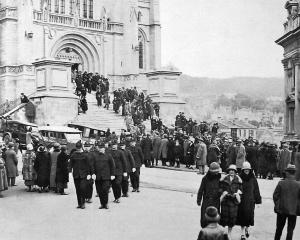
However, Dunedin Tramways Union president Gary Bedford said if the Otago Regional Council was looking to change the road code, it would need massive public support.
Council chairwoman Cr Gretchen Robertson wrote to Transport Minister Chris Bishop late last month looking for a change to Land Transport (Road User) Rule 2004 (Part 4) to prioritise buses leaving bus stops.
"With a lack of bus priority infrastructure and increasing congestion, especially in Queenstown, it is increasingly difficult for buses to re-enter traffic flows from a bus stop," she said.
"Buses in New Zealand currently rely solely on other road users’ courtesy to merge back into general traffic flow when egressing from a bus stop.
"This compromises service reliability and increases operating costs," she said.
Mr Bedford yesterday said give-way rules for buses worked elsewhere, but he was doubtful a change was likely here unless every bus driver and "just about every passenger" on New Zealand buses called for it along with the unions.
Stickers on buses now asking drivers to give way to buses were largely ignored.
About 40% of drivers let buses back into traffic while "the rest ... they won't stop at all".
The status quo was "dynamite" — on busy stretches of road when buses pulled into stops, they would get stuck there until a driver chose to let them out, Mr Bedford said.
Cr Robertson’s letter, dated April 30, is included in today’s council agenda.
It said NZ Transport Agency Waka Kotahi research several years ago showed a legislative change that gave buses leaving bus stops priority over general traffic would bring benefits.
"The research also concluded any disbenefits to other road users of a law change would be either marginal or negligible," the letter said.
A change would improve the reliability of bus service run times, reduce operational costs, and make buses a more attractive option for people who now drove their own cars.

Mr Bishop replied to the council yesterday and provided his response to the Otago Daily Times.
He said he appreciated the benefits that could arise from allowing buses leaving stops to have priority over general traffic — especially during peak travel — "but these need to be weighed up against general road safety concerns".
"While I acknowledge that you have highlighted the disbenefits as being marginal or negligible, previous investigations into whether rules of this type should be introduced in New Zealand highlighted possible safety issues, including that contradicting the general give-way rules could cause confusion for drivers and vulnerable road users."
The government’s Road Safety Objectives document was released in October.
One of the government’s priorities for road safety was to improve safety on footpaths, shared paths and bus and cycle lanes.
This would include consideration of proposed changes related to a bus egress give-way rule, he said.
"I expect to receive advice from my officials on this matter in the coming months," Mr Bishop said.
"Any changes will be informed through public consultation."
Bus Users Support Group Ōtepoti co-president Alex King said other options for giving buses priority, such as dedicated bus lanes, were very expensive, whereas this proposal was a very inexpensive way of achieving bus priority without spending a lot of money and without inconveniencing other road users, Mr King said.
It was important that buses could travel as quickly as possible because they serviced more people than an individual car.
Getting more people to where they wanted to go more quickly would make buses a more attractive option.
"Therefore, it's going to take some cars off the road and reduce the overall congestion as well."













